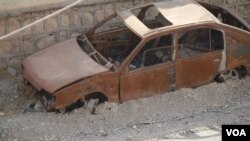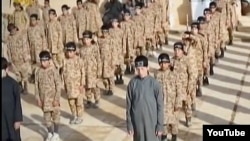Islamic State propagandists posted a 42-minute video online Wednesday that included the drowning in a fish tank of an alleged Iraqi spy and the beheading of another, as well as drone footage of more than a dozen suicide bombings in northern Iraq undertaken by teenage boys and a one-legged old man.
The video is the latest in a sudden surge of big production propaganda material being posted by the terror group. In the past few months, the jihadists’ media output had decreased significantly, likely as the result of the military pressure IS has come under across its self-declared caliphate in both Iraq and Syria.
Just days before the IS-claimed New Year’s Eve attack on the Reina nightclub in Istanbul that left 39 dead, the group released a video of two Turkish soldiers being forced to crawl on all fours before being burned alive. First posted with an Arabic language commentary on December 22 and re-released Monday with an English language voice-over, the video accused Turkish President Recep Tayyip Erdogan of siding with apostates and the Christian West.
And just after Christmas, IS propagandists released a chilling half-hour video of child jihadists as young as nine years old participating in live-fire training exercises, shooting first at dummies and then at captives with their hands bound and trying to elude them in a debris-strewn building. In the video, captives are shown weeping after being cornered by the mini mob of indoctrinated boys, who gun them down at point-blank range.
Scenes in the video included the boys, known as cubs of the caliphate, taking Quran classes, studying execution videos and pledging allegiance to terror leader, Abu Bakr al-Baghdadi, while brandishing automatic weapons.
Military challenges
The media surge is a response to the increasingly dangerous military challenge the group is facing, says former U.S. ambassador Alberto Fernandez, now with The Middle East Media Research Institute, a Washington-based research organization that monitors jihadist propaganda.
“Just like IS has tried to surge in its overseas attacks and responded fiercely to military advances in northern Syria and Mosul, they are trying to fight against the idea that they are in an inexorable decline,” he says.
The video posted this week recalls earlier 2014 IS productions in terms of slickness and editing techniques.
It begins with footage of multiple VBIED (vehicle-borne improvised explosive device) suicide attacks carried out by jihadists in Mosul. Suicide bombers are interviewed by IS videographers before bombing runs. One bomber is crippled and wheeled off to his waiting bomb-rigged vehicle in a wheelchair. As with others, his attack and its aftermath are filmed by a drone.
Analysts have noted in recent months a sharp drop in the output of Islamic State propaganda, which is largely credited with having helped the terror group recruit an estimated 30,000 foreign fighters. Last year, the group posted online a fraction of the videos and images it produced in 2014 and 2015, and has for months appeared to be struggling to maintain production as it has come under growing pressure from foes on the battlefield, according to researchers.
A study released in October by the Combating Terrorism Center at the U.S. Military Academy at West Point, showed there had been a plunge, with a decline from a peak of 761 releases a month in August of 2015, to just 194 a year later.
“It is clear the organization has been forced to cut back these activities in response to the increasing amount of pressure brought to bear,” concluded the West Point researchers.
Dwindling resources
They argued the decline is evidence IS finds it a challenge to devote the personnel and secure the resources to keep up production rates of its propaganda bid.
Most of the reduction in media output has likely been a direct consequence of military offensives against the group in Iraq and Syria, which have seen the territory controlled by the jihadists reduced dramatically. Media production facilities have been destroyed and propagandists killed in airstrikes. They include two of the terror group’s top propagandists, Abu Muhammad al-Adnani, who personally selected execution videos and was killed in late August, and his replacement, Abu Muhammad Furqan, who was killed a month later.
Analysts point out the latest long-form videos produced by IS in recent weeks are less experimental and don’t exhibit the more complex and demanding techniques used in IS videos in 2014 and 2015. Aside from the drone footage, less demanding filming and editing techniques are used in the video posted Wednesday.
The terror group’s propagandists also appear to be struggling to produce multi-language versions of videos. In 2014 and 2015, videos were posted in different language versions at the same time. Now the videos tend only to be in Arabic.










